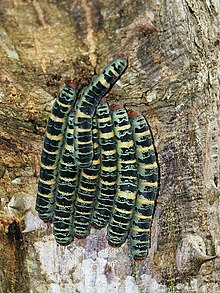Arsenura armida
| Arsenura armida | ||||||||||||
|---|---|---|---|---|---|---|---|---|---|---|---|---|

Arsenura armida , male |
||||||||||||
| Systematics | ||||||||||||
|
||||||||||||
| Scientific name | ||||||||||||
| Arsenura armida | ||||||||||||
| ( Cramer , 1779) |

Arsenura armida is occurring in Central and South America butterfly ( moth ) from the family of saturniidae (Saturniidae).
description
butterfly
The moths reach a wingspan of 100 to 120 millimeters. There is a slight sexual dimorphism between the sexes . In the males, the base color of the wing tops is light brown. The post-disc and sub-marginal regions are darker brown and crisscrossed by a black, whitish wavy line. Discal spots are reduced to thin dark brown lines. The hind wings point at the apex . In the females, the basal and disk regions are bright yellow. The apex of the hind wings is round.
Caterpillar
Young caterpillars are ringed black and yellow and have short black hair behind the head and on the anus. Fully grown caterpillars are dark green and yellowish, sometimes ringed black and reddish brown and ocher on the sides.
In some areas of Mexico , the very protein-rich caterpillars are sometimes used as food by the local ethnic groups .
Distribution and occurrence
The main distribution area of Arsenura armida is in Mexico, Bolivia , Ecuador and in southeastern Brazil . The species prefers to colonize dry tropical deciduous forests.
Way of life
The main flight time of the first generation of butterflies are the months May to August. A second generation, whose moths fly between October and December, is only formed occasionally. The caterpillars develop after the rainy season. Young caterpillars are sociable. Older caterpillars may eat leaves individually, but when they are resting, they usually gather in large groups on tree trunks and then sit tightly together. By means of a pheromone , which they leave as a trail on the branches of their hiking trails, they always find their way back to their resting places. The frequent occurrence of many individuals and the bright coloration of the caterpillars probably serve to deter predators. The caterpillars feed on the leaves of various deciduous tree species, including: Guazuma ulmifolia , Rollinia membranace and Bombacopsis quinatum .
Trivia
The species was first described by Pieter Cramer in 1779 . As early as 1705, the natural scientist and artist Maria Sibylla Merian published an illustration (colored copper engraving) of a butterfly with caterpillars from today's genus Arsenura within the work Metamorphosis insectorum Surinamensium (Metamorphosis of the Surinamese insects). It could well be Arsenura armida .
literature
James T. Costa: The Other Insect Societies . Harvard University Press, Cambridge, Massachusetts 2006, ISBN 978-0-674-02163-1 .
Individual evidence
- ↑ Jun Mitsuhashi: Edible Insects of the World , CRC Press Taylor & Francis, Boca Raton, Fl., 2017, ISBN 978-1-4987-5657-0
- ↑ a b c James T. Costa: Arsenura armida , Department of Biology Western Carolina University, Cullowhee, NC 28723, USA. (viewed at http://web.cortland.edu/fitzgerald/arsenura.html on October 18, 2017)
Web links
- belizemoths - adults
- overview eol.org - Encyclopedia of Life
- funet.fi - dissemination

